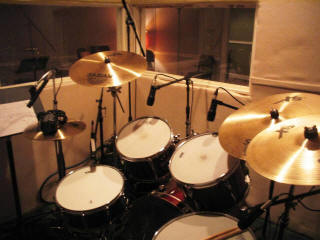This article was first
published
on CLUAS in September 2008
The Making of an Album, part 3: Recording
Third of a four part guide to recording an album...
 Last
time in our series on the making of an album, we discussed the
choice of a location to record. Whether
you choose a studio or go mobile, the preparation is pretty much the same.
However, the engineer should organise any extra equipment that needs to be
rented should you go mobile.
Last
time in our series on the making of an album, we discussed the
choice of a location to record. Whether
you choose a studio or go mobile, the preparation is pretty much the same.
However, the engineer should organise any extra equipment that needs to be
rented should you go mobile.
Before you set foot in the studio, though, you should have a look at the
condition of your instruments. The majority of bands are made up of guitarists,
bassist, drummer and maybe a keyboard player. Take your guitars and basses to be
serviced by a professional; don't do it yourself unless you are supremely
confident! The last thing you need is to be in the middle of a session and you
discover your intonation is out. Also, if your amps are buzzing get them sorted
out too. The less time spent fixing problems during the sessions, the better.
Buy a decent tuner too and make sure it's used to tune everything.
When it comes to the drums, get new skins and make sure that they're well
stretched. Don't bother taking too long to tune them as you will probably have
to re-tune them in the studio. Some kits are also prone to rattling and
squeaking. Strip them down and make sure you tighten all that needs tightening
and oil all that is squeaking.
Keyboards and samplers are pretty straightforward. If they work then great. If
they don't then get them repaired. Any other instruments you might have, like
mandolins, violins, cellos and bagpipes, should be looked at too!
One other piece of prep work is to get your drummer used to a click track. I
know that those two words can be more offensive to a drummer than if you were to
question his parentage but if a drummer is well used to one then your recordings
will sound much more consistent. Also, a click track makes previously
unrepairable mistakes repairable and allows for loops and samples to be easily
flown into the songs. Be aware too that click tracks don't have to be blips and
ticks; they can be percussion loops, drum loops or even a manually recorded
shaker or tambourine.
We now have all our prep work done, hopefully, so next up is what happens in the
studio. Get there early; for mobile work there will be a lot of setting up to
do. The engineer should have chosen an area for each musician, so set up there
and make it comfortable. One idea that has served well on many an album is to
buy a large artist’s pad and write down the name of each song on a separate
page. As you start recording you can tick off what needs to be done. This not
only shows what is left to do but also, if you are in the middle of a
particularly difficult take, you can glance over and see what you have already
achieved.
There are a few different ways to set up for the initial recording. A preferred
way is to separate all the noise sources as much as possible. An example would
be to drag the amps out into different rooms. Once that is done you can play
together as a band and any mistakes can be later repaired easily. If, however,
you have an amp in the same room as the drum kit and the guitarist hits a howler
then the drum mics will pick that up and the whole take is ruined! All the
musicians will still be in the same room wearing headphones and maintaining line
of sight but the only audible noise is the drum kit.
Some more experienced bands set up everything in one room. As mentioned earlier,
this could sound great but one mistake ruins an entire take. Another option is
to pre-record vocal and guitar "guides" to a click track. The drums and bass can
then record take after take while the rest of the band can take a breather and
listen to the takes. This can work out well but having the whole band in the one
place can create a kind of energy that might not be easily replicated in this
way. You'll find that as the session progresses all of the above options might
eventually be used along with some others.
Now you're well in to the recording process, doing take after take and making
sure to tune in between each one. Make sure you don't overdo it too soon. The
excitement of the recording, coupled with the goal of perfection, means that
it's all too easy to burn out too soon. Take regular breaks, get some air and go
for walks. You have 10 or so songs that have to be given the same attention and
passion. Please be aware too that the engineer needs a break; it's easy to
forget that the one person who can't take a break unless the entire band do is
the engineer!
Also, if you work for 15 hours a day for 3 straight days you will get tired
and the later recordings might not be up to scratch. If they have to be
re-recorded then you will end up spending far more time and money on the album
than is needed. Once the recording is finished for the day, relax and have a
drink or two. Don't drink or "smoke" during the recording if you can help it.
You're there to work, not to get langered.
Once the basic drum, bass and rhythm tracks are done, the next step is the
overdubbing stage. As mentioned last time, it might be an idea while mobile to
set up a dead room for the vocals, but you don't necessarily need a large studio
to do this. Indeed, there are many project studios that can meet your needs for
a fraction of the price of a studio or going mobile. When you are overdubbing as
before make sure you take your time, and if you get stuck on trying to get a
certain take then move on and come back to it later. Nothing is more annoying
than spending 2 hours trying to get a guitar lick right. You may laugh, but a
lot of bands can do the hard stuff really well and get stuck on the simple
things.
So, we have all of the recording finished and it all sounds great. Next up is
the editing and mixing stage. We'll get on to that in the next part of this
series.
Andy Knightley
This is the 3rd part of 4 part series of articles on 'Making an album'. Check out the other articles:
The author Andy Knightley is a sound engineer who runs Krecording, which provides mobile recording and the facilities of Studio 57 in Dublin. He has recorded the likes of Sinead O'Connor, Bell X1, Damien Dempsey, Lir, Ronnie Drew (RIP), The Rags, Pilotlight, Le Galaxie/66e, Vasco Junior and Michele Ann Kelly. If you have any questions for Andy, feel free to contact him at info@krecording.com
